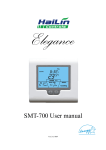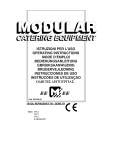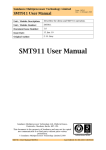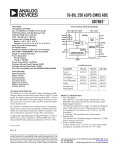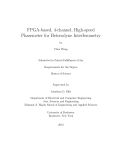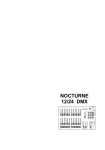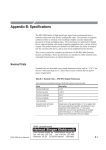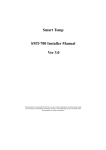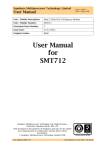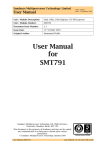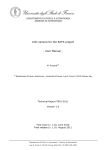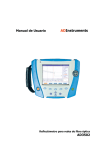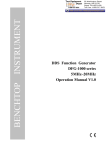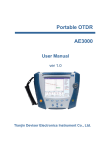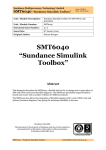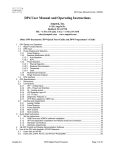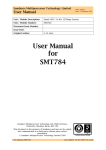Download User Manual for SMT916 - Sundance Multiprocessor Technology Ltd.
Transcript
Unit / Module Description: Twelve 16-bit ADC module (10 MSPS) Unit / Module Number: SMT916 Document Issue Number: 1.1 Issue Date: 08/07/2011 Original Author: Philippe Robert User Manual for SMT916 Sundance Multiprocessor Technology Ltd, Chiltern House, Waterside, Chesham, Bucks. HP5 1PS. This document is the property of Sundance and may not be copied nor communicated to a third party without prior written permission. © Sundance Multiprocessor Technology Limited 2009 Revision History Issue Changes Made Date Initials 1 Original document released 06/07/2011 PhSR 1.1 Ordering information added 08/07/2011 PhSR Table of Contents 1 2 Introduction ................................................................................................................... 6 Related Documents....................................................................................................... 7 2.1 Referenced Documents .............................................................................................. 7 2.2 Applicable Documents ............................................................................................... 7 3 Functional Description ................................................................................................ 7 3.1 Block Diagram.............................................................................................................. 7 3.2 Module Description .................................................................................................... 8 3.3 Interface Description.................................................................................................. 8 3.3.1 Mechanical Interface .............................................................................................. 8 3.3.2 Electrical Interface ................................................................................................. 8 3.3.2.1 Analogue inputs ............................................................................................ 8 3.3.2.2 Digital Inputs ................................................................................................. 8 3.3.2.3 Digital output ................................................................................................ 9 3.3.2.4 VCC/Ground planes ..................................................................................... 9 3.3.2.5 ADC common mode voltage ....................................................................... 9 3.3.2.6 Input dual opamp structure ..................................................................... 10 3.4 Firmware ..................................................................................................................... 10 3.4.1 FPGA Block Diagram. ........................................................................................... 10 3.4.2 Global Control Register – 0x4 ............................................................................ 11 3.4.3 Global Status Register – 0x4 .............................................................................. 13 3.4.4 Conversion rate register channels 0 to 5 – 0x10. .......................................... 14 3.4.5 Conversion rate register channels 6 to 11 – 0x11. ........................................ 15 3.4.6 Storage Control Register – 0x12 ........................................................................ 15 3.4.7 ADCs Output Format GroupA – 0x13 .............................................................. 17 3.4.8 ADCs Output Format GroupB – 0x14 ............................................................... 17 3.4.9 Led Register – 0x15 .............................................................................................. 17 3.4.10 Channel Selection for read back operation – 0x20. ....................................... 18 3.4.11 Channel 0 – IODelay – 0x30. .............................................................................. 18 3.4.12 Channel 1 – IODelay – 0x31. .............................................................................. 18 3.4.13 Channel 2 – IODelay – 0x32. .............................................................................. 19 3.4.14 Channel 3 – IODelay – 0x33. .............................................................................. 19 3.4.15 Channel 4 – IODelay – 0x34. .............................................................................. 19 3.4.16 Channel 5 – IODelay – 0x35. .............................................................................. 20 3.4.17 Channel 6 – IODelay – 0x36. .............................................................................. 20 3.4.18 Channel 7 – IODelay – 0x37. .............................................................................. 20 3.4.19 Channel 8 – IODelay – 0x38. .............................................................................. 20 3.4.20 Channel 9 – IODelay – 0x39. .............................................................................. 21 3.4.21 Channel 10 – IODelay – 0x3A. ............................................................................ 21 3.4.22 Channel 11 – IODelay – 0x3B. ............................................................................ 21 4 Verification Procedures ............................................................................................. 22 Power Consumption – Heat dissipation. ................................................................ 22 5 5.1 AD7626 ADC Chip. ................................................................................................... 22 5.2 Linear regulators. ...................................................................................................... 22 5.3 Clock distribution chips. ......................................................................................... 23 5.4 Power consumption .................................................................................................. 23 6 PCB Layout ................................................................................................................... 23 6.1 ADC Channel .............................................................................................................. 23 6.2 Top Layer .................................................................................................................... 25 6.3 Bottom Layer .............................................................................................................. 25 7 Performance ................................................................................................................. 26 7.1 DC Input – 10MSPS. .................................................................................................. 26 8 Pinout ............................................................................................................................ 27 9 Physical Properties ..................................................................................................... 27 10 Safety ............................................................................................................................. 28 11 Cooling .......................................................................................................................... 28 12 EMC ................................................................................................................................ 28 13 Ordering Information ................................................................................................. 28 Table of Figures Figure 1 – SMT916 Block Diagram. ........................................................................................ 7 Figure 2 - ADCs common mode voltage. .............................................................................. 9 Figure 3 - ADCs input front-end. .......................................................................................... 10 Figure 4 - Firmware Block Diagram...................................................................................... 11 Figure 5 - ADC Channel Layout. ........................................................................................... 24 Figure 6 - Top Layout. ............................................................................................................. 25 Figure 7 - Bottom Layout........................................................................................................ 25 Figure 8 – DC Input distribution - 4k samples - 10MSPS. ................................................ 26 Figure 9 – DC Input - Time domain - 10MSPS. ................................................................... 26 Figure 10 – DC Input - Frequency domain - 10MSPS. ....................................................... 27 Figure 11 - DC Input - Distribution of all 12 channels..................................................... 27 1 Introduction The SMT916 is an SLB mezzanine board that incorporates twelve AD7626 ADC chips from Analog Devices (Two groups of six ADCs, Group A for the first six channels and Group B for the next six channels). Converters are 16-bit SAR (Successive Approximation Register), with a maximum throughput of 10MSPS. Analog input connectors on the board all MMCX. This module can be mated with one Sundance’s SLB base modules such as the SMT351T (Virtex5 FPGA, DDR2 memory), SMT372T (Virtex5 FPGA coupled with two 6-core TI DSPs, Ethernet) or SMT700 (Virtex5 FPGA, PXIe bus, USB, Ethernet, SATA). Note that the Base module is required to be set to 2.5V IOs in order not to damage the SMT916. ADCs will be working as two groups of 6 converters, all in ‘self-clocked’ mode. Each group will be working simultaneously. The FPGA on the SLB base module is responsible for triggering ADC conversions. The distribution of the conversion signal will be ensured by two CDCLVD2106 chips from Texas Instrument. It features low pin to pin skew (below 50ps) and low additive jitter (below 100ps). Samples are collected by the FPGA using a serial LVDS link. Bits are clocked out of the ADCs at a speed of 250MHz. Individual state machines synchronised to the conversion signal ensure this process. The FPGA generates a serial clock that is be distributed among the converters (2 groups of 6) using an LVDS clock distribution chip (CDCLVD2106). The front-end is implemented around 2 amplifiers (Analog Devices) allowing DC levels. The input impedance will be 50 Ohms (or more depending on option purchased). An anti-aliasing filter follows the amplifiers before signal reach the ADCs. Cut-off frequency is half of the maximum ADC sampling rate (5MHz). ADCs are driven differentially. When it comes to synchronisation among several modules, an external clock input (slave mode) and an external clock output (master mode) connectors are present as well as a SYNC input connector to synchronise state machines between boards. An external trigger is also present on the board. All four lines are connected to an FPGA IO and protected by clamping diodes (3.3V). MMCX connectors are used. 2 Related Documents 2.1 Referenced Documents 2.2 Applicable Documents Analog Devices: AD7626 datasheet. Texas Instrument: CDCLVC2106 datasheet. Sundance: SLB specifications. Sundance: SMT351T. Sundance: SMT372T. Sundance: SMT700. 3 Functional Description 3.1 Block Diagram S ig nal C onditioning A D 7 626 16 bits - 10 M S P S C ha nnel 0 1 x L V D S da ta lin e M MCX 50-O hm S ig nal C onditioning A D 7 626 16 bits - 10 M S P S C ha nnel 1 1 x LV D S d ata line M MCX 50-O hm S ig nal C onditioning A D 7 626 16 bits - 10 M S P S C ha nnel 2 1 x LV D S d ata line M MCX 50-O hm S ig nal C onditioning A D 7 626 16 bits - 10 M S P S C ha nnel 3 1 x LV D S d ata line M MCX 50-O hm S ig nal C onditioning A D 7 626 16 bits - 10 M S P S C ha nnel 4 1 x LV D S d ata line M MCX 50-O hm S ig nal C onditioning A D 7 626 16 bits - 10 M S P S C ha nnel 5 1 x LV D S d ata line M MCX 50-O hm P S U A D C s: 12 x 2.5-V olts S upp lies. 12 x 5-V olts S upp lies. P ow e r D augh te r C ard con nector SLB G rou p A C lock Input (used in S lave m od e) MM CX 50-O hm T rig ger Input MM CX 50-O hm S yn c Inpu t MM CX 50-O hm C lock O utput (used in M aster m ode) LV D S C lock D istrib ution C hip 6 o utputs – C D C L V P 2 1 0 6 (1/2) LV D S C lock D istrib ution C hip 6 ou tp uts – C D C L V P 2 1 0 6 (1/2) C on version S yn chro nisatio n an d C lo cks – 4 line s LV D S C lock D istrib ution C hip 6 o utputs – C D C L V P 2 1 0 6 (2/2) MM CX 50-O hm LV D S C lock D istribution C hip 6 o utputs – C D C L V P 2 1 0 6 (2/2) S ig nal C onditioning A D 7 626 16 bits - 10 M S P S C ha nnel 6 1 x LV D S d ata line M MCX 50-O hm S ig nal C onditioning A D 7 626 16 bits - 10 M S P S C ha nnel 7 1 x LV D S d ata line M MCX 50-O hm S ig nal C onditioning A D 7 626 16 bits - 10 M S P S C ha nnel 8 1 x LV D S d ata line M MCX 50-O hm M MCX 50-O hm S ig nal C onditioning A D 7 626 16 bits - 10 M S P S C ha nnel 9 1 x LV D S d ata line S ig nal C onditioning A D 7 626 16 bits - 10 M S P S C h annel 1 0 1 x LV D S d ata line M MCX 50-O hm M MCX 50-O hm S ig nal C onditioning A D 7 626 16 bits - 10 M S P S C h annel 1 1 1 x LV D S d ata line G ro up B Figure 1 – SMT916 Block Diagram. D augh ter C ard interface co nnector SLB The above block diagram shows how converters are driven and linked to the SLB connector. The FPGA implements states machines to generate conversion pulses. They are then distributed to both groups (Group A and Group B) of 6 ADCs. Further in the state machine, eighteen 250MHz clock cycles are generated to get the 16-bit sample out of the converter (serial LVDS line) – 2 extra bits being used to synchronise data and the fpga internal clock. This process will be repeated in order to collect more samples. The 250-MHz clock is distributed among the converter using a TI distribution chip. LVDS lines are used between the FPGA, the clock distribution chips and the analogue converters in order to avoid any noise to be picked up. 3.2 Module Description Clock distribution chips are all from Texas Instrument. Converters are from Analog Devices. All MMCX connectors are accessible from the top of the module. 3.3 Interface Description 3.3.1 Mechanical Interface The SMT916 comes as an SLB mezzanine module. It is coupled with an SLB base module. The mezzanine plugs into the base module via an SLB data connector and an SLB power connector. Some Nylon screws ensure that modules don’t move and guarantee best connection. The SMT916 does not follow the SLB specifications in terms of dimensions. The board area will identical to an standard SLB base module. 3.3.2 Electrical Interface 3.3.2.1 Analogue inputs All twelve analog inputs will be 50-ohm (other values are available on order) terminated and accept signals within the range 0-4Volts. Analog inputs have got parallel diodes used as ESD protection, which will prevent any input voltage higher than 5 volts to reach the front-end. 3.3.2.2 Digital Inputs There are 3 digital inputs, External Clock Input, External Trigger Input and External Sync Input. They are part of the group of 4 connectors (bottom left of the board). Digital inputs, just like analog inputs have got parallel diodes used as ESD protection, which will prevent any input voltage higher than 5 volts to reach the front-end. A Buffer is used on each line to pass the signal to the FPGA. Minimum Input levels: 1V peak-to-peak. Maximum Input Level: 3.3V peak to peak. Maximum frequency: 200MHz. 3.3.2.3 Digital output There is one Digital Output, External Sync Out. It is part of the group of 4 connectors (bottom left of the board). A Buffer is used between the FPGA and the connector. Output Level: 0-3.3Volts 3.3.2.4 VCC/Ground planes The module is powered from the SLB power module. Each ADC is connected to an independent power rail in order to be less likely subject to cross-talk and shared noises. Each ADC channel will have its own independent ground plane and independent power supplies. Each ADC ground plane will join (star type layout) the ‘SLB’ ground plane in one point using 0-Ohm resistors. 3.3.2.5 ADC common mode voltage The ADC common mode voltage is divided by 2 in the chip. It is then fed into an opamp in order to ‘align’ analogue input and ADC internal voltages. Figure 2 - ADCs common mode voltage. An AD8031 is used to route the common mode voltage from the ADC to the input opamp. 3.3.2.6 Input dual opamp structure The analogue input on the connector is single ended. Two opamps are used to provide positive and negative differential lines to the ADC. Both are centred on the common mode voltage to ensure maximum scale and linearity. Figure 3 - ADCs input front-end. AD8021 opamps are used as able to match 16-bit ADC converters inputs. They receive symmetrical power supplies provided by LDOs belonging to the same family, ensuring a better symmetry. 3.4 Firmware The firmware shown below is what has been designed to be implemented in the FPGA of an SMT372T. 3.4.1 FPGA Block Diagram. The block diagram of the firmware is shown below. An Ethernet interface is used to communicate with the DSP (dspa). Control registers are collected from there. Main settings will be the enable channel bits to activate ADC channels individually, to set the rate of the sampling frequency (also called conversion rate), to trigger storage units and to program individual iodelay (one setting per ADC channel). ADCs are configured into self-clock mode. The FPGA sends to each ADC (via clock distribution chip) a clock that the converter uses to serialise samples out. In order for the FPGA to latch serial data in, it needs to re-align internally an image of the clock it sends to the converters with the incoming data. This is implemented using idelays. An initialisation routine will be run at start-up in order to work out the delay required. Serial data is then turned into a 16-bit word. The data flow is routed to a storage unit, which when enabled, allows data in. The storage units are enabled via a trigger signal that could be coming from a register or a connector (external trigger input – MMCX). Data capture into storage unit happens simultaneously for all 12 channels. The DSP is responsible for collecting data, one channel at a time. The mux selects the current channel. Samples are transferred to the DSP via an Ethernet interface. By default Storage unit are set to 4k samples (only 2k when calibrating/aligning data line with clock – as an extra 2 bits are attached to the 16bit sample words). Figure 4 - Firmware Block Diagram. Registers implemented in the register block are described in the following parts of this document. 3.4.2 Global Control Register – 0x4 Global control Register – 0x4 (Write-only register). Byte Bit 7 Bit 6 Bit 5 Bit 4 Bit 3 Bit 2 Bit 1 Bit 0 1 Clock Source External Clock Output Enable Reserved ADC11 Enable ADC10 Enable ADC9 Enable ADC8 Enable Selection External Clock PLL reset Default ‘0’ ‘0’ ‘0’ ‘0’ ‘0’ ‘0’ ‘0’ ‘0’ 0 ADC7 Enable ADC6 Enable ADC5 Enable ADC4 Enable ADC3 Enable ADC2 Enable ADC1 Enable ADC0 Enable Default ‘0’ ‘0’ ‘0’ ‘0’ ‘0’ ‘0’ ‘0’ ‘0’ Global control Register – 0x4 (Write-only register). Setting Bit 0 Description – ADC0 Enable 0 0 ADC0 interface is disabled. 1 1 Normal Mode of Operation – ADC0 interface is enabled. Setting Bit 1 Description – ADC1 Enable 0 0 ADC1 interface is disabled. 1 1 Normal Mode of Operation – ADC1 interface is enabled. Setting Bit 2 Description – ADC2 Enable 0 0 ADC2 interface is disabled. 1 1 Normal Mode of Operation – ADC2 interface is enabled. Setting Bit 3 Description – ADC3 Enable 0 0 ADC3 interface is disabled. 1 1 Normal Mode of Operation – ADC3 interface is enabled. Setting Bit 4 Description – ADC4 Enable 0 0 ADC4 interface is disabled. 1 1 Normal Mode of Operation – ADC4 interface is enabled. Setting Bit 5 Description – ADC5 Enable 0 0 ADC5 interface is disabled. 1 1 Normal Mode of Operation – ADC5 interface is enabled. Setting Bit 6 Description – ADC6 Enable 0 0 ADC6 interface is disabled. 1 1 Normal Mode of Operation – ADC6 interface is enabled. Setting Bit 7 Description – ADC7 Enable 0 0 ADC7 interface is disabled. 1 1 Normal Mode of Operation – ADC7 interface is enabled. Setting Bit 8 Description – ADC8 Enable 0 0 ADC8 interface is disabled. 1 1 Normal Mode of Operation – ADC8 interface is enabled. Setting Bit 9 Description – ADC9 Enable 0 0 ADC9 interface is disabled. 1 1 Normal Mode of Operation – ADC9 interface is enabled. Setting Bit 10 Description – ADC10 Enable 0 0 ADC10 interface is disabled. 1 1 Normal Mode of Operation – ADC10 interface is enabled. Setting Bit 11 Description – ADC11 Enable 0 0 ADC11 interface is disabled. 1 1 Normal Mode of Operation – ADC11 interface is enabled. Setting Bit 13 0 0 Disabled. 1 1 External Clock Output Enabled. Setting Bit 14 0 0 Description – External Clock Out Enable Description – External Clock PLL Reset PLL not under Reset. 1 1 PLL in reset mode. Does not auto-clear.. Setting Bit 15 0 0 FPGA Clock (on-board 25-MHz clock) )used to generate conversion rate and capture clock (system clock). 1 1 External Clock used to generate conversion rate and capture clock (system clock). Description – Clock Source Selection Note that ADC0 enable bit also enables the conversion signal for group a. Same applies to ADC6 for group b of ADCs. The PLL reset (External clock) can be needed when switching to external clock in order to force the PLL to lock. The Lock status can be read from the Global Status Register. 3.4.3 Global Status Register – 0x4 Global Status Register – 0x4 (Read-only register). Byte Bit 7 Bit 6 Bit 5 Bit 4 Bit 3 Bit 2 Bit 1 Bit 0 1 Clock Source External PLL Locked External Clock Output Enable Reserved ADC11 Enable ADC10 Enable ADC9 Enable ADC8 Enable Selection Default ‘0’ ‘0’ ‘0’ ‘0’ ‘0’ ‘0’ ‘0’ ‘0’ 0 ADC7 Enable ADC6 Enable ADC5 Enable ADC4 Enable ADC3 Enable ADC2 Enable ADC1 Enable ADC0 Enable Default ‘0’ ‘0’ ‘0’ ‘0’ ‘0’ ‘0’ ‘0’ ‘0’ Global control Register – 0x4 (Write register). Setting Bit 0 Description – ADC0 Enable 0 0 ADC0 interface is disabled. 1 1 Normal Mode of Operation – ADC0 interface is enabled. Setting Bit 1 Description – ADC1 Enable 0 0 ADC1 interface is disabled. 1 1 Normal Mode of Operation – ADC1 interface is enabled. Setting Bit 2 Description – ADC2 Enable 0 0 ADC2 interface is disabled. 1 1 Normal Mode of Operation – ADC2 interface is enabled. Setting Bit 3 Description – ADC3 Enable 0 0 ADC3 interface is disabled. 1 1 Normal Mode of Operation – ADC3 interface is enabled. Setting Bit 4 Description – ADC4 Enable 0 0 ADC4 interface is disabled. 1 1 Normal Mode of Operation – ADC4 interface is enabled. Setting Bit 5 Description – ADC5 Enable 0 0 ADC5 interface is disabled. 1 1 Normal Mode of Operation – ADC5 interface is enabled. Setting Bit 6 Description – ADC6 Enable 0 0 ADC6 interface is disabled. 1 1 Normal Mode of Operation – ADC6 interface is enabled. Setting Bit 7 Description – ADC7 Enable 0 0 ADC7 interface is disabled. 1 1 Normal Mode of Operation – ADC7 interface is enabled. Setting Bit 8 Description – ADC8 Enable 0 0 ADC8 interface is disabled. 1 1 Normal Mode of Operation – ADC8 interface is enabled. Setting Bit 9 Description – ADC9 Enable 0 0 ADC9 interface is disabled. 1 1 Normal Mode of Operation – ADC9 interface is enabled. Setting Bit 10 Description – ADC10 Enable 0 0 ADC10 interface is disabled. 1 1 Normal Mode of Operation – ADC10 interface is enabled. Setting Bit 11 Description – ADC11 Enable 0 0 ADC11 interface is disabled. 1 1 Normal Mode of Operation – ADC11 interface is enabled. Setting Bit 13 0 0 Disabled. 1 1 External Clock Output Enabled. Setting Bit 14 0 0 PLL not locked. 1 1 PLL locked. Setting Bit 15 0 0 FPGA Clock (on-board 25-MHz clock) )used to generate conversion rate and capture clock (system clock). 1 1 External Clock used to generate conversion rate and capture clock (system clock). Description – External Clock Out Enable Description – External Clock PLL Lock status Description – Clock Source Selection Note that ADC0 enable bit also enables the conversion signal for group a. Same applies to ADC6 for group b of ADCs. 3.4.4 Conversion rate register channels 0 to 5 – 0x10. A 12-bit register is implemented in the firmware in order to define the sampling frequency of the ADCs. There is one per group of 6 ADCs, so top and bottom ADCs can work at different rates. The sampling frequency registers must be loaded with a multiple of 4ns that makes the sampling period. The block implemented in the FPGA is clocked at 250MHz, hence the 4ns step. For instance, a 100ns sampling period (equivalent to 10MHz sampling frequency) would require loading in the register a value of 100/4=25 (that’s 0x19 hexadecimal). ADCs work at a minimum sampling period of 100ns and a maximum of 10000ns, defining a range of values for the registers of 25 (0x19) to 2500 (0x9C4). The first 4 values of the counter enable the conversion signal, which therefore stays high for 16ns. It remains low until the entire cycle is completed. The duty cycle follows the AD9676 specifications. A simple 12-bit counter is used to implement this function. It counts up until it reaches the value loaded in the sampling frequency register. The counter is enabled by the channel counter enable bits of the global control register. Sampling Frequency Register ADC5...0 (Group A) – 0x10 (Read-Write register). Byte Bit 7 Bit 6 Bit 5 Bit 4 Bit 3 Bit 2 Bit 1 1 Reserved Sampling Frequency Register[11...8] Default “0000” “0000” 0 Sampling Frequency Register[7...0] Default “00000000” Bit 0 Sampling Frequency Register ADC5...0 (Group A) – 0x10 (Read-Write register). Setting Bit 11...0 0 Description – Sampling Frequency Register ADC5...0 Value between 0x19 and 0x9C4 to be programmed, respectively matching with maximum sampling rate (10MHz) and minimum sampling rate (100KHz) of the ADC. ADC0....5 are sampling at the same rate. 3.4.5 Conversion rate register channels 6 to 11 – 0x11. Sampling Frequency Register ADC6...11 (Group B) – 0x11 (Read-Write register). Byte Bit 7 Bit 6 Bit 5 Bit 4 Bit 3 Bit 2 Bit 1 1 Reserved Sampling Frequency Register[11...8] Default “0000” “0000” 0 Sampling Frequency Register[7...0] Default “00000000” Bit 0 Sampling Frequency Register ADC6...11 (Group B) – 0x11 (Read-Write register). Setting Bit 11...0 0 Description – Sampling Frequency Register ADC11...6 Value between 0x19 and 0x9C4 to be programmed, respectively matching with maximum sampling rate (10MHz) and minimum sampling rate (100KHz) of the ADC. ADC6....11 are sampling at the same rate. 3.4.6 Storage Control Register – 0x12 Storage Control Register – 0x12 (Write-only register). Byte Bit 7 Bit 6 Bit 5 Bit 4 Bit 3 Bit 2 Bit 1 Bit 0 1 Reserved Reserved Reserved Reserved Start Storage ADC11 Start Storage ADC10 Start Storage ADC9 Start Storage ADC8 Default ‘0’ ‘0’ ‘0’ ‘0’ ‘0’ ‘0’ ‘0’ ‘0’ 0 Start Storage ADC7 Start Storage ADC6 Start Storage ADC5 Start Storage ADC4 Start Storage ADC3 Start Storage ADC2 Start Storage ADC1 Start Storage ADC0 Default ‘0’ ‘0’ ‘0’ ‘0’ ‘0’ ‘0’ ‘0’ ‘0’ Storage Control Register – 0x12 (Write-only register). Setting Bit 0 Description – Start Storage ADC0 0 0 No action 1 1 Triggers the storage of samples coming from ADC0 interface. Setting Bit 1 0 0 No action 1 1 Triggers the storage of samples coming from ADC1 interface. Setting Bit 2 0 0 No action 1 1 Triggers the storage of samples coming from ADC2 interface. Setting Bit 3 0 0 No action 1 1 Triggers the storage of samples coming from ADC3 interface. Setting Bit 4 0 0 No action 1 1 Triggers the storage of samples coming from ADC4 interface. Setting Bit 5 0 0 No action 1 1 Triggers the storage of samples coming from ADC5 interface. Setting Bit 6 0 0 No action 1 1 Triggers the storage of samples coming from ADC6 interface. Setting Bit 7 0 0 No action 1 1 Triggers the storage of samples coming from ADC7 interface. Setting Bit 8 0 0 No action 1 1 Triggers the storage of samples coming from ADC8 interface. Setting Bit 9 0 0 No action 1 1 Triggers the storage of samples coming from ADC9 interface. Setting Bit 10 0 0 No action 1 1 Triggers the storage of samples coming from ADC10 interface. Setting Bit 11 0 0 No action 1 1 Triggers the storage of samples coming from ADC11 interface. Description – Start Storage ADC1 Description – Start Storage ADC2 Description – Start Storage ADC3 Description – Start Storage ADC4 Description – Start Storage ADC5 Description – Start Storage ADC6 Description – Start Storage ADC7 Description – Start Storage ADC8 Description – Start Storage ADC9 Description – Start Storage ADC10 Description – Start Storage ADC11 Each storage unit has a content of 4096 samples. Samples are first stored into the unit (FIFO) and then transferred to the DSP once the path has been selected. All Start Storage bits do auto clear. All can be activated simultaneously for simultaneous captures. 3.4.7 ADCs Output Format GroupA – 0x13 ADCs Output Format GroupA – 0x13 (Read-Write register). Byte Bit 7 Bit 6 Bit 5 Bit 4 Bit 3 Bit 2 Bit 1 Bit 0 1 Reserved Reserved Reserved Reserved Reserved Reserved Reserved Reserved Default ‘0’ ‘0’ ‘0’ ‘0’ ‘0’ ‘0’ ‘0’ ‘0’ 0 Reserved Reserved Reserved Reserved Reserved Reserved Output Format bit1 Output Format bit0 Default ‘0’ ‘0’ ‘0’ ‘0’ ‘0’ ‘0’ ‘0’ ‘0’ ADCs Output Format GroupA – 0x13 (Read-Write register). Setting Bit 1:0 Description - Output Format GroupA - ADC0...5 0 00 For Calibration routine. 1 01 Two’s complement samples - capture. 2 10 Binary samples - capture. 3 11 Zeroes. 3.4.8 ADCs Output Format GroupB – 0x14 ADCs Output Format GroupB – 0x14 (Read-Write register). Byte Bit 7 Bit 6 Bit 5 Bit 4 Bit 3 Bit 2 Bit 1 Bit 0 1 Reserved Reserved Reserved Reserved Reserved Reserved Reserved Reserved Default ‘0’ ‘0’ ‘0’ ‘0’ ‘0’ ‘0’ ‘0’ ‘0’ 0 Reserved Reserved Reserved Reserved Reserved Reserved Output Format bit1 Output Format bit0 Default ‘0’ ‘0’ ‘0’ ‘0’ ‘0’ ‘0’ ‘0’ ‘0’ ADCs Output Format GroupB – 0x14 (Read-Write register). Setting Bit 1:0 Description - Output Format GroupB - ADC0...5 0 00 For Calibration routine 1 01 Two’s complement samples - capture. 2 10 Binary samples - capture. 3 11 Zeroes. 3.4.9 Led Register – 0x15 There are 12 LEDs on the SMT916 controlled by a register. They are controlled individually by writing ones or zeroes in this register. Storage Control Register – 0x15 (Read-Write register). Byte Bit 7 Bit 6 Bit 5 Bit 4 Bit 3 Bit 2 Bit 1 Bit 0 1 Reserved Reserved Reserved Reserved LED11 LED10 LED9 LED8 Default ‘0’ ‘0’ ‘0’ ‘0’ ‘0’ ‘0’ ‘0’ ‘0’ 0 LED7 LED6 LED5 LED4 LED3 LED2 LED1 LED0 Default ‘0’ ‘0’ ‘0’ ‘0’ ‘0’ ‘0’ ‘0’ ‘0’ 3.4.10 Channel Selection for read back operation – 0x20. Channel Selection for read back operation – 0x20 (Read-Write register). Byte Bit 7 Bit 6 Bit 5 Bit 4 Bit 3 Bit 2 Bit 1 0 Reserved Selection Default “0000” “0000” Bit 0 Channel Selection for read back operation – 0x20 (Read-Write register). Setting Bit 3...0 Description – Channel Selection 3 “1101” ADC11 (Group B) channel is connect – to read samples collected and stored into storage unit ... ... 2 “0010” ADC1 (Group A) channel is connect – to read samples collected and stored into storage unit 1 “0001” ADC0 (Group A) channel is connect – to read samples collected and stored into storage unit 0 “0000” Register read back On the SMT916, Group A is made out of ADC0-5 and Group B is composed of ADC611. 3.4.11 Channel 0 – IODelay – 0x30. Channel 0 - IODelay – 0x30 (Read-Write register). Byte Bit 7 Bit 6 Bit 5 Bit 4 Bit 3 Bit 2 0 Reserved IODelay Default “00” “000000” Bit 1 Bit 0 Bit 1 Bit 0 Channel 0 - IODelay – 0x30 (Read-Write register). Setting Bit 5...0 0 Description – Channel Selection Must be a value between 0 and 63. Delay step is 78pS. 3.4.12 Channel 1 – IODelay – 0x31. Channel 1 - IODelay – 0x31 (Read-Write register). Byte Bit 7 Bit 6 Bit 5 Bit 4 Bit 3 Bit 2 0 Reserved IODelay Default “00” “000000” Channel 0 - IODelay – 0x31 (Read-Write register). Setting Bit 5...0 0 Description – Channel Selection Must be a value between 0 and 63. Delay step is 78pS. 3.4.13 Channel 2 – IODelay – 0x32. Channel 2 - IODelay – 0x32 (Read-Write register). Byte Bit 7 Bit 6 Bit 5 Bit 4 Bit 3 Bit 2 0 Reserved IODelay Default “00” “000000” Bit 1 Bit 0 Bit 1 Bit 0 Bit 1 Bit 0 Channel 2 - IODelay – 0x32 (Read-Write register). Setting Bit 5...0 0 Description – Channel Selection Must be a value between 0 and 63. Delay step is 78pS. 3.4.14 Channel 3 – IODelay – 0x33. Channel 3 - IODelay – 0x33 (Read-Write register). Byte Bit 7 Bit 6 Bit 5 Bit 4 Bit 3 Bit 2 0 Reserved IODelay Default “00” “000000” Channel 3 - IODelay – 0x33 (Read-Write register). Setting Bit 5...0 0 Description – Channel Selection Must be a value between 0 and 63. Delay step is 78pS. 3.4.15 Channel 4 – IODelay – 0x34. Channel 4 - IODelay – 0x34 (Read-Write register). Byte Bit 7 Bit 6 Bit 5 Bit 4 Bit 3 Bit 2 0 Reserved IODelay Default “00” “000000” Channel 4 - IODelay – 0x34 (Read-Write register). Setting 0 Bit 5...0 Description – Channel Selection Must be a value between 0 and 63. Delay step is 78pS. 3.4.16 Channel 5 – IODelay – 0x35. Channel 5 - IODelay – 0x35 (Read-Write register). Byte Bit 7 Bit 6 Bit 5 Bit 4 Bit 3 Bit 2 0 Reserved IODelay Default “00” “000000” Bit 1 Bit 0 Bit 1 Bit 0 Bit 1 Bit 0 Bit 1 Bit 0 Channel 5 - IODelay – 0x35 (Read-Write register). Setting Bit 5...0 0 Description – Channel Selection Must be a value between 0 and 63. Delay step is 78pS. 3.4.17 Channel 6 – IODelay – 0x36. Channel 6 - IODelay – 0x36 (Read-Write register). Byte Bit 7 Bit 6 Bit 5 Bit 4 Bit 3 Bit 2 0 Reserved IODelay Default “00” “000000” Channel 6 - IODelay – 0x36 (Read-Write register). Setting Bit 5...0 0 Description – Channel Selection Must be a value between 0 and 63. Delay step is 78pS. 3.4.18 Channel 7 – IODelay – 0x37. Channel 7 - IODelay – 0x37 (Read-Write register). Byte Bit 7 Bit 6 Bit 5 Bit 4 Bit 3 Bit 2 0 Reserved IODelay Default “00” “000000” Channel 7 - IODelay – 0x37 (Read-Write register). Setting Bit 5...0 0 Description – Channel Selection Must be a value between 0 and 63. Delay step is 78pS. 3.4.19 Channel 8 – IODelay – 0x38. Channel 8 - IODelay – 0x38 (Read-Write register). Byte Bit 7 Bit 6 Bit 5 Bit 4 Bit 3 Bit 2 0 Reserved IODelay Default “00” “000000” Channel 8 - IODelay – 0x38 (Read-Write register). Setting Bit 5...0 0 Description – Channel Selection Must be a value between 0 and 63. Delay step is 78pS. 3.4.20 Channel 9 – IODelay – 0x39. Channel 9 - IODelay – 0x39 (Read-Write register). Byte Bit 7 Bit 6 Bit 5 Bit 4 Bit 3 Bit 2 0 Reserved IODelay Default “00” “000000” Bit 1 Bit 0 Bit 1 Bit 0 Bit 1 Bit 0 Channel 9 - IODelay – 0x39 (Read-Write register). Setting Bit 5...0 0 Description – Channel Selection Must be a value between 0 and 63. Delay step is 78pS. 3.4.21 Channel 10 – IODelay – 0x3A. Channel 10 - IODelay – 0x3A (Read-Write register). Byte Bit 7 Bit 6 Bit 5 Bit 4 Bit 3 Bit 2 0 Reserved IODelay Default “00” “000000” Channel 10 - IODelay – 0x3A (Read-Write register). Setting Bit 5...0 0 Description – Channel Selection Must be a value between 0 and 63. Delay step is 78pS. 3.4.22 Channel 11 – IODelay – 0x3B. Channel B - IODelay – 0x3B (Read-Write register). Byte Bit 7 Bit 6 Bit 5 Bit 4 Bit 3 Bit 2 0 Reserved IODelay Default “00” “000000” Channel B - IODelay – 0x3B (Read-Write register). Setting 0 Bit 5...0 Description – Channel Selection Must be a value between 0 and 63. Delay step is 78pS. 4 Verification Procedures Connections between base and mezzanine module will be verified by either probing on the board itself or by a mean of sending and checking known data from a host server. ADC performance will be verified channel by channel as well as crosstalk between channels. 5 Power Consumption – Heat dissipation. 5.1 AD7626 ADC Chip. Three - power supplies are required for the AD7626: VDD1 (5 Volts), with a maximum current of 11.2mA (56mW), VDD2 (2.5 Volts), with a maximum current of 27.8mA (69.5mW), IO (2.5 Volts), with a maximum current of 17.8mA (44.5mW). The total power consumed/dissipated by one ADC (5mm x 5mm package) is equivalent to 170mW. With a thermal resistance (Junction to ambient) of 40˚C/W, the elevation in temperature will be 6.8˚C. These figures are acceptable and no heatsink should be required for the module to be used in a open environment. 5.2 Linear regulators. All 3 rails mentioned in the previous section (ADC) will be coming out of linear regulator with high-PSRR where switching frequencies of DC/DC using on base modules are. TPS793xx family from Texas Instrument will be used on the SMT916. Regulators come is small packages (5-pin BGA – YZQ). This specific package shows a thermal resistance of 255˚C/W (worst case). A 5-Volt fixed linear regulator will be used and connected to the 12-volt rail available on the SLB power connector. Power dissipation will be 78.4mW, which is equivalent to rise in temperature of 20˚C above ambient. 2.5-Volt fixed linear regulators will be used and connected on the 3.3-volt rail coming from the SLB power connector. Power dissipation of each regulator will be 22mW (VDD2) and 14.24mW (VIO), which is equivalent an increase in temperature of respectively 5.6˚C and 3.6˚C above ambient. No extra cooling should be required here. The input stage is composed of 2 amplifiers (AD8021 from Analog Devices). Both require symmetrical power supplies: +7 Volts and -7 Volts. TPS7A3001 and TPS793001 regulators will be used. Less than 10mA will be drawn by each supply, that’s 20mA in total per supply, generating a dissipation of 0.1 Watt (taken from a 12-volt input rail), equivalent to rise of temperature above ambient of 5.6˚C. No extra cooling should be required here. 5.3 Clock distribution chips. Clock distribution chips are used to route the clock used to read samples out of the ADCs and to generate the ADC conversion signals. A part from Texas Instrument is used to implement both functions: CDCLVD2106. They are 2.5V chips and require a maximum of 177mA of current. In order to provide a clean supply rail two linear regulators will be used (derived from 3.3-Volt rail on SLB Power connector). The estimated power dissipated per regulator is 142mW. A regulator of the TPS793xx family will be suitable but in a bigger package than the ones used for the converters in order to spread the heat more efficiently. 5.4 Power consumption The EVP6472-916 system, while running the demo code requires a power a 16.8 Watts (that’s 1.4amps on a 12Volt supply). 6 PCB Layout 6.1 ADC Channel Below is shown the ADC layout, including opamps, ESD protection, MMCX connector and individual power supplies. Figure 5 - ADC Channel Layout. Twelve ADC channels will be available on the SMT916, all based on the same above model. 6.2 Top Layer Figure 6 - Top Layout. 6.3 Bottom Layer Figure 7 - Bottom Layout. 7 Performance 7.1 DC Input – 10MSPS. DC input distribution has been measured by feeding the ADC internal reference onto the input connector. The capture below shows the distribution in value of the captured samples, followed by its FFT. The 4k-capture is spread over 5 values as follows: Number of points Sample value 126 32711 1256 32712 2054 32713 640 32714 20 32715 Figure 8 – DC Input distribution - 4k samples - 10MSPS. Figure 9 – DC Input - Time domain - 10MSPS. Figure 10 – DC Input - Frequency domain - 10MSPS. The table below show the linearity across all twelve channels: Figure 11 - DC Input - Distribution of all 12 channels. 8 Pinout To be defined. VHDL interface (state machine) could be designed prior to pcb in order to validate a pinout that meet timing requirements in the FPGA. 9 Physical Properties Dimensions W x L x H : 63.5mm x 106.7mm x 18mm (est.) Weight 40 grams (est.) Supply Voltages +12V, +5V, +3.3V and -12V Supply Current +12V : tbd +5V : tbd +3.3V : tbd -12V : tbd MTBF 10 Safety This module presents no hazard to the user when in normal use. 11 Cooling The SMT916 board requires an air flow to ensure good operating conditions. Typically, a 30-CFM fan is enough to keep a system such as the EVP6472-916 at a good level. 12 EMC This module is designed to operate from within an enclosed host system, which is build to provide EMC shielding. Operation within the EU EMC guidelines is not guaranteed unless it is installed within an adequate host system. This module is protected from damage by fast voltage transients originating from outside the host system which may be introduced through the output cables. Short circuiting any output to ground does not cause the host PC system to lock up or reboot. 13 Ordering Information Three options are currently available, 50-Ohm, 1-KOhm and 20-KOhm input termination, below are the part numbers when ordering the boards. SMT916-50R: SMT916 with twelve 50-ohm terminated analog inputs. SMT916-1K: SMT916 with twelve 1K-ohm terminated analog inputs. SMT916-20K: SMT916 with twelve 20k-ohm terminated analog inputs.




























